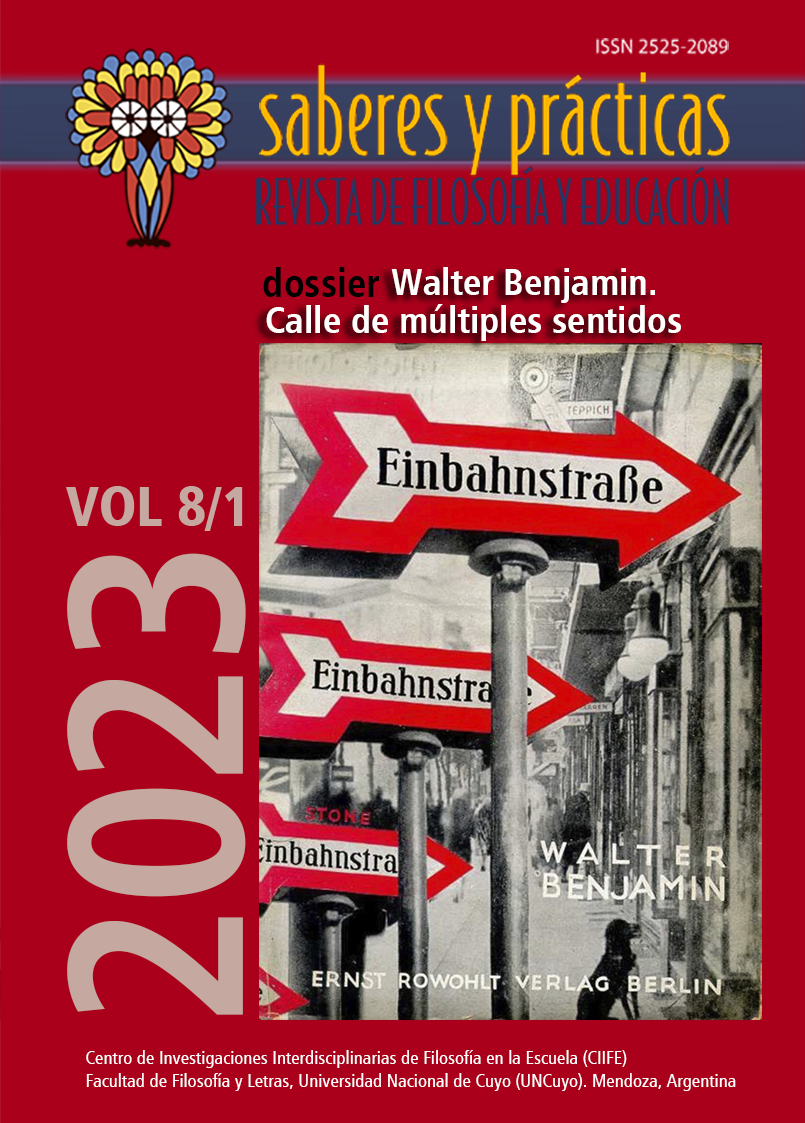Imitation as a Pedagogical Strategy for Teaching Art and Philosophy
DOI:
https://doi.org/10.48162/rev.36.084Keywords:
Art, Philosophy, Philosophy education, Art education, Art imitation, PedagogyAbstract
This article explores the role of imitation in the teaching of visual arts and literature in elementary education on the one hand, and philosophy in secondary education on the other. It begins by analyzing the role of imitation in the teaching of visual arts and literature, where it is found that imitation should be understood as an activity of personal appropriation and not as a mechanical reproduction. This finding allows us to criticize the tendency to consider that talent is the product of an innate capacity that ignores the creative tradition. It is also evident that the result of imitation, paradoxically, is creativity and originality, to the extent that it provides the student with a base of different creative styles, to combine or improve them, building his own style. Then, some ideas are offered on how this strategy can be applied to the teaching of philosophy in secondary education, through three classic ways of doing philosophy. The similarity between the pedagogical methods makes it possible to establish interesting links between the nature of the two areas of knowledge, with respect to the creative act. The artist creates his work in a similar way as the philosopher creates the concept; in both cases, although the product is unique and particular, it has pretensions of universality. Both Art and Philosophy rebel against some characteristics of instrumental reason, insofar as they value learning to linger in contemplation and reflection, and value the impossibility of enclosing their products under some defined utility. In this sense, both Art and Philosophy stand as paradigms of human freedom.
Downloads
References
Agirre, I. (2005). Teorías y prácticas en educación artística. Octaedro.
Aristotle. (1995) Poetics. Edited and translated by Stephen Halliwell. Loeb Classical Library.
Deleuze, G., Guattari, F. (1997) ¿Qué es la filosofía? Traducción de Thomas Kauf. Anagrama.
Eisner, E., & Day, M. (2004). Handbook of Research and Policy in Art Education. Lawrence Erlbaum Associates Publishers.
Flórez, A. (2011) La forma del diálogo y la forma de la filosofía en Platón. Franciscanum. Revista de las Ciencias del Espíritu. Vol. 3, Nº 156. (pp. 369-398).
Han, B. (2020). La desaparición de los rituales. Traducción de Alberto Ciria. Herder.
Heidegger, M. (2006) ¿Qué es la Filosofía? Herder.
Kant, I. (1998) Sobre el saber filosófico. Colección Excerpta Philosophica.
Krautz, J., Sowa, H. (2017) Mimesis. Zur kunstpädagogischen Aktualität eines alten Prinzips. IMAGO. Zeitschrift für Kunstpädagogik 4 (pp. 4-13). https://kopaed.de/kopaedshop/?pg=3_58&qt=35&pid=1056
Laercio, D. (2004) Vidas, opiniones y sentencias de los filósofos más ilustres. Tomo I (traducidas directamente del griego por José Ortiz y Sanz). Biblioteca Virtual Miguel de Cervantes. http://www.cervantesvirtual.com/nd/ark:/59851/bmcxd0v4
Lowenfeld, V. y Brittain Lambert, W. (1980). Desarrollo de la capacidad creadora. Kapelusz.
Messina, L. (2020) Wa. La vía japonesa de la armonía. Aguilar.
Murphy, J. (1990) Roman Writing Instruction as Described by Quintilian. En James J. Murphy. (Ed.) A Short History of Writing Instruction: From Ancient Greece to Twentieth-Century America (pp. 19-76).
Nietzsche, F. (1994) Aurora. Estudio de la moral como prejuicio. M.F. Editores S.L.
Platón. (2021). Teeteto. Diálogos V. (Trad. Álvaaro Vallejo Campos). Gredos.
Platón. (2021). Laques. Diálogos I. (Trad. C. García Gual). Gredos.
Raquimán Ortega, P. & Zamorano Sanhueza, M. (2017). Didáctica de las Artes Visuales, una aproximación desde sus enfoques de enseñanza. Estudios pedagógicos. 43 (1), 439-456. https://dx.doi.org/10.4067/S0718-07052017000100025
Rothko, M. (2004). The Artist’s reality philosophies of art. Yale University Press New Haven and London.
Savater, F. (2010). Historia de la Filosofía. Sin temor ni temblor. Planeta.
Shields, S. (2007) The Art of Imitation. The English Journal. Vol. 96, No. 6, (pp. 56-60).
Vargas, J.P., Ramírez, J. y Duica, W. (2018). Democracia, filosofía y verdad: tres ensayos de John Dewey. Señal que cabalgamos (109). Universidad Nacional de Colombia, 31-57.
Wittgenstein, L. (1976). Cuaderno azul. Los cuadernos azul y marrón. Tecnos.
Wittgenstein, L. (1981). Observaciones. Siglo XXI.
Wittgenstein, L. (1988). Investigaciones Filosóficas. (Traducción castellana de Alfonso García Suárez y Ulises Moulines). UNAM-Editorial Crítica.
Published
How to Cite
Issue
Section
License
Copyright (c) 2023 Víctor Emilio Parra Leal
This work is licensed under a Creative Commons Attribution-NonCommercial-ShareAlike 2.5 Argentina License.









